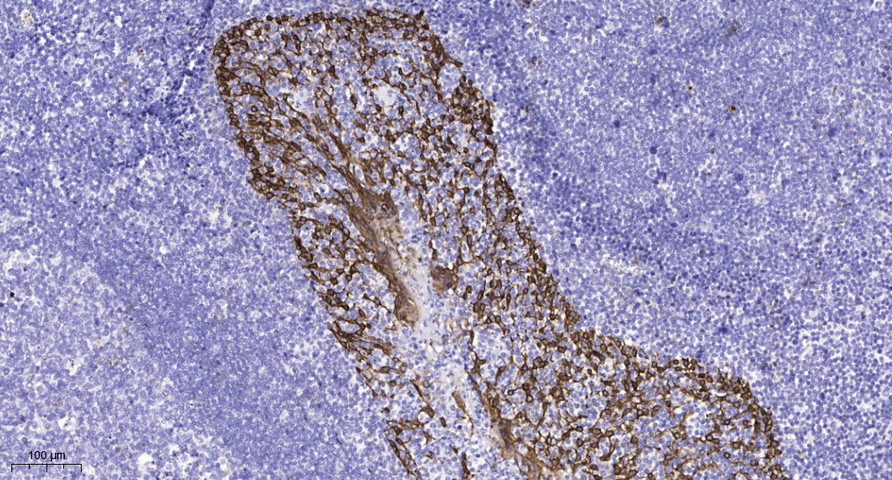Kv4.2 (phospho Ser616) Polyclonal Antibody
- Catalog No.:YP1005
- Applications:IHC;IF;ELISA
- Reactivity:Human;Mouse;Rat
- Target:
- Kv4.2
- Fields:
- >>Serotonergic synapse
- Gene Name:
- KCND2
- Protein Name:
- Potassium voltage-gated channel subfamily D member 2
- Human Gene Id:
- 3751
- Human Swiss Prot No:
- Q9NZV8
- Mouse Gene Id:
- 16508
- Mouse Swiss Prot No:
- Q9Z0V2
- Rat Gene Id:
- 65180
- Rat Swiss Prot No:
- Q63881
- Immunogen:
- Synthesized phospho-peptide around the phosphorylation site of human Kv4.2 (phospho Ser616)
- Specificity:
- Phospho-Kv4.2 (S616) Polyclonal Antibody detects endogenous levels of Kv4.2 protein only when phosphorylated at S616.
- Formulation:
- Liquid in PBS containing 50% glycerol, 0.5% BSA and 0.02% sodium azide.
- Source:
- Polyclonal, Rabbit,IgG
- Dilution:
- IHC 1:100 - 1:300. ELISA: 1:5000.. IF 1:50-200
- Purification:
- The antibody was affinity-purified from rabbit antiserum by affinity-chromatography using epitope-specific immunogen.
- Concentration:
- 1 mg/ml
- Storage Stability:
- -15°C to -25°C/1 year(Do not lower than -25°C)
- Other Name:
- KCND2;KIAA1044;Potassium voltage-gated channel subfamily D member 2;Voltage-gated potassium channel subunit Kv4.2
- Molecular Weight(Da):
- 71kD
- Background:
- Voltage-gated potassium (Kv) channels represent the most complex class of voltage-gated ion channels from both functional and structural standpoints. Their diverse functions include regulating neurotransmitter release, heart rate, insulin secretion, neuronal excitability, epithelial electrolyte transport, smooth muscle contraction, and cell volume. Four sequence-related potassium channel genes - shaker, shaw, shab, and shal - have been identified in Drosophila, and each has been shown to have human homolog(s). This gene encodes a member of the potassium channel, voltage-gated, shal-related subfamily, members of which form voltage-activated A-type potassium ion channels and are prominent in the repolarization phase of the action potential. This member mediates a rapidly inactivating, A-type outward potassium current which is not under the control of the N terminus as i
- Function:
- domain:The segment S4 is probably the voltage-sensor and is characterized by a series of positively charged amino acids at every third position.,function:Pore-forming (alpha) subunit of voltage-gated rapidly inactivating A-type potassium channels. May contribute to I(To) current in heart and I(Sa) current in neurons. Channel properties are modulated by interactions with other alpha subunits and with regulatory subunits.,PTM:Phosphorylated on serine and threonine residues.,similarity:Belongs to the potassium channel family. D (Shal) subfamily.,subcellular location:Detected in dendrites in cultured hippocampal neurons. Association with KCNIP2 probably enhances cell surface expression.,subunit:Homotetramer or heterotetramer with KCND1 and/or KCND3. Interacts with DPP6, DLG4 and FREQ (By similarity). Interacts with DLG1. Associates with the regulatory subunits KCNIP1, KCNIP2, KCNIP3 and KCNI
- Subcellular Location:
- Cell membrane ; Multi-pass membrane protein . Cell projection, dendrite . Cell junction, synapse . Perikaryon . Cell junction, synapse, postsynaptic cell membrane . Cell projection, dendritic spine . Cell junction . In neurons, primarily detected on dendrites, dendritic spines and on the neuron cell body, but not on axons. Localized preferentially at the dendrites of pyramidal cells in the hippocampus CA1 layer. Detected at GABAergic synapses. Detected at cell junctions that are distinct from synaptic cell contacts. Detected in lipid rafts. Detected primarily at the endoplasmic reticulum or Golgi when expressed by itself (PubMed:15454437). Interaction with KCNIP1, KCNIP2, KCNIP3 or KCNIP4 promotes expression at the cell membrane (PubMed:15454437, PubMed:24811166). Interaction with DPP6 or
- Expression:
- Detected in ovary, in corpus luteum and in granulosa and theca cells in the follicle (at protein level) (PubMed:15991246). Highly expressed throughout the brain (PubMed:10551270, PubMed:10729221). Detected in amygdala, caudate nucleus, cerebellum, hippocampus, substantia nigra and thalamus (PubMed:10551270, PubMed:10729221). Expression is not detectable or very low in heart, kidney, liver, lung, pancreas and skeletal muscle (PubMed:10551270, PubMed:10729221). Not detectable in human heart atrium (PubMed:12395204).
- June 19-2018
- WESTERN IMMUNOBLOTTING PROTOCOL
- June 19-2018
- IMMUNOHISTOCHEMISTRY-PARAFFIN PROTOCOL
- June 19-2018
- IMMUNOFLUORESCENCE PROTOCOL
- September 08-2020
- FLOW-CYTOMEYRT-PROTOCOL
- May 20-2022
- Cell-Based ELISA│解您多样本WB检测之困扰
- July 13-2018
- CELL-BASED-ELISA-PROTOCOL-FOR-ACETYL-PROTEIN
- July 13-2018
- CELL-BASED-ELISA-PROTOCOL-FOR-PHOSPHO-PROTEIN
- July 13-2018
- Antibody-FAQs
- Products Images

- Immunohistochemical analysis of paraffin-embedded human tonsil. 1, Antibody was diluted at 1:200(4° overnight). 2, Tris-EDTA,pH9.0 was used for antigen retrieval. 3,Secondary antibody was diluted at 1:200(room temperature, 45min).



